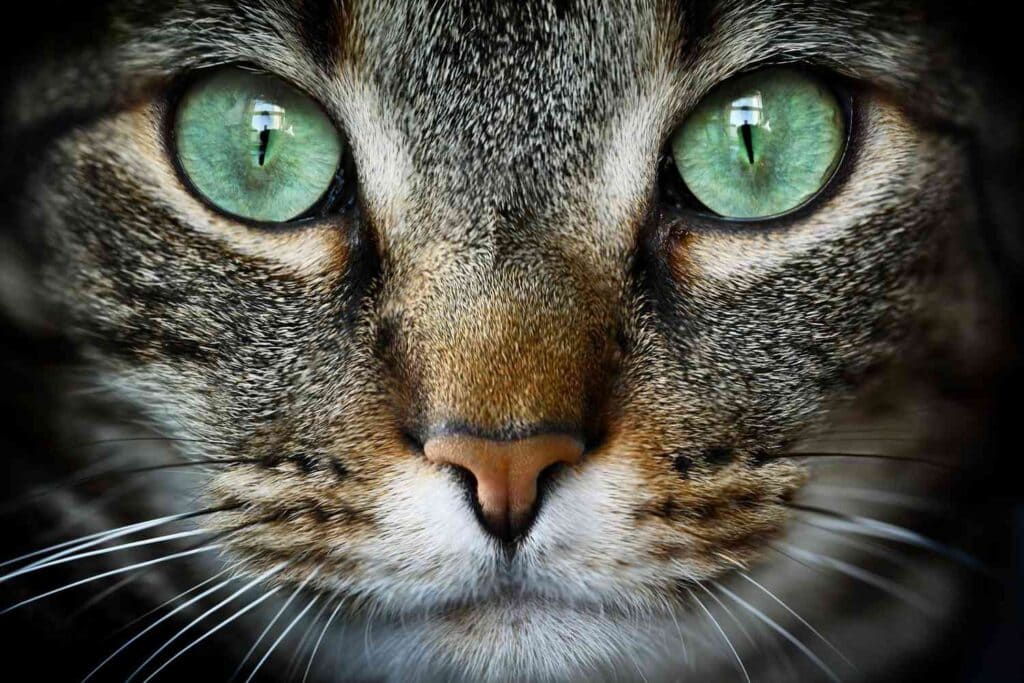Table of Contents
The Feline Spectrum: Exploring What Colors Cats Can See
Understanding the world through a cat’s eyes offers a fascinating glimpse into how our feline friends perceive their environment. While human color vision is rich and varied, cats’ color vision is somewhat limited. However, they are far from color blind and possess a unique range of color perception that suits their needs.
The Basics Cat Vision
We must examine the structure of cats’ eyes to understand their vision. Rod and cone cells are the two types of photoreceptor cells found in cats. Cats can see well in low light due to the remarkable sensitivity of their rod cells to low light. They need this adaptability to continue their nighttime hunting habits. Contrarily, cone cells are in charge of perceiving color. Because we have three different kinds of cone cells in our eyes, humans can perceive an extensive range of colors and have trichromatic vision. Cats’ color vision is more limited since they only have two types of cone cells in their bodies.
Discover the fascinating world of cat genetics! Uncover the secrets behind the stunning coat colors and intricate patterns that make each feline unique. Dive into the science and history of our furry friends’ appearances. Don’t miss out, click here to explore more about the captivating genetics of cat coat colors and patterns!
What Colors Can Cats See?

Scientists have been curious about what colors cats can see for a long time. According to research, cats have trouble telling the difference between red and orange, but they can see certain shades of green and blue. As a result, although they can perceive blue and yellow tones, they may have trouble with reddish-orange hues. Since cats’ eyesight is comparable to that of people who are red-green color blind, the majority of red-green color variations are included in the list of colors that cats cannot see.
Blue and yellow-green tones seem the easiest for cats to recognize when it comes to colors. This particular sensitivity is probably an evolutionary adaptation that helps them find food and navigate their surroundings.
How Cats See the World
There is more to a cat’s visual perception than just color. In other areas where human vision is inadequate, cats excel. For example, a larger number of rod cells in their eyes allows them to see far better in low light. This modification and their vertically slitted pupils enable superior motion detection and depth perception—both essential for a predatory lifestyle.
Interestingly, there is a price for being so sensitive to low light. Compared to humans, cats’ color perception is less subtle overall, and they are not as good observers in high light. In spite of this, their perception of color is vital to how they connect with the outside environment.
lets have a look and discover the fascinating world of cat breeds! From the regal Maine Coon to the playful Bengal, there’s a perfect feline friend waiting for you. Explore our comprehensive guide to learn more about their unique traits, care needs, and histories. Click here to dive into the enchanting realm of our furry companions and find your ideal match!
Practical Implications for Cat Owners

Knowing which colors cats can see will improve our interactions with them. For instance, your feline companion may find greater engagement in a blue or yellow-green toy. Compared to red or orange toys, which may seem more subdued to them, cats are more likely to react to these colors.
Furthermore, by using this knowledge, situations that are more engaging for cats can be designed. Enhancing rooms with components that fall into their color perception range can help them feel more at ease and engaged.
Dogs vs. Cats-A Comparison
One could wonder, “What colors can cats see versus what dogs can perceive? while comparing the visual acuity of cats and dogs. Dogs and cats have two different types of cone cells, making them dichromats. Dogs’ preference for blue and yellow hues in color vision is comparable to that of cats. However, they may have different depth perception and motion sensitivity.
The Evolutionary Perspective

It’s amazing to learn about the evolution of feline vision. Their heightened ability to detect motion and see in low light levels is a trade-off for their poor perception of color. This evolutionary adaption implies that their ability to identify prey and travel through various lighting situations is more important for survival than brilliant, colorful hues.
Conclusion
In conclusion, research into cats’ color spectrum indicates a distinct visual environment adapted to their nocturnal and predatory lifestyle. Cats see mostly blue and yellow-green colors; they can see reddish-orange colors only dimly. Their eyesight is not designed to see a wide range of colors but is tuned to detect movement and navigate in low light.
Our ability to engage with and care for cats can be greatly improved by being aware of the colors cats see best and their overall visual capabilities. Understanding the subtleties of cats’ color perception can help us design more exciting and fulfilling spaces for our furry friends. Therefore, the next time you choose a new cat toy, remember to choose one that is blue or yellow-green and make sure your cat will like and love it.

